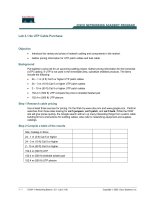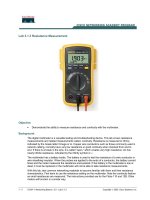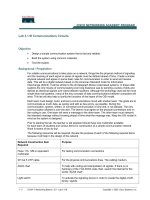Lab 3.1.9d Rollover Cable Construction
Bạn đang xem bản rút gọn của tài liệu. Xem và tải ngay bản đầy đủ của tài liệu tại đây (130.93 KB, 3 trang )
Lab 3.1.9d Rollover Cable Construction
Objective
• Build a Category 5 or Category 5e (CAT 5 or 5e) Unshielded Twisted Pair (UTP) console rollover
cable.
• Test the cable for continuity and correct pin-outs, the correct wire on the right pin.
Background
This will be a 4-pair "rollover" cable. This type of cable is typically 3.05 m (10 ft) long but can be as
long as 7.62 m (25 ft). A rollover cable can be used to connect a workstation or dumb terminal to the
console port on the back of a Cisco router or switch. Both ends of the cable built will have RJ-45
connectors on them. One end plugs directly into the RJ-45 console management port on the back of
the router or switch. Plug the other end into an RJ-45-to-DB9 terminal adapter. This adapter converts
the RJ 45 to a 9-pin female D connector for attachment to the PC or dumb terminal serial (COM)
port. A DB25 terminal adapter is also available to connect with a PC or dumb terminal. This adapter
uses a 25 pin connector. The following picture shows a rollover console cable kit that ships with most
Cisco devices.
For all practical purposes, in the last lab when building the straight through jumper, putting the
second RJ-45 on upside down would have made a rollover cable instead. This cable is called a
rollover because the pins on one end are all reversed on the other end as though one end of the
cable was rotated or rolled over.
Prior to starting the lab, the teacher or lab assistant should have a spool of Cat 5 or Cat 5e UTP
cable, RJ-45 (8-pin) connectors, an RJ-45 crimping tool and a continuity tester available. Work
individually or in teams. The following resources will be required:
1 - 3 CCNA 1: Networking Basics v 3.0 - Lab 3.1.9d Copyright 2003, Cisco Systems, Inc.
• One 3.05 to 6.1 m (10 to 20 ft) length of Cat 5 cabling per person or per team
• Four RJ-45 connectors, two are extra for spares
• RJ-45 crimping tools to attach the RJ-45 connectors to the cable ends
• An RJ-45 to DB9 female terminal adapter, available from Cisco
• Cabling continuity tester
• Wire cutters
Step 1
Use the table as a reference to help create a rollover console cable.
Signal Legend: RTS = Request To Send, DTR = Data Terminal Ready, TxD = Transmit Data, GND
= Ground (One for TxD and one for RxD), RxD = Receive Data, DSR = Data Set Ready, CTS =
Clear To Send.
Step 2
Determine the distance between devices, then add at least 30.48 cm (12 in.) to the distance. Make
the cable about 3.05 m (10 ft), unless connecting to router or switch from a greater distance. The
maximum length for this cable is about 8m (approx 25 ft).
Step 3
Strip 5.08 cm (2 in.) of jacket off of one end of the cable.
Step 4
Hold the 4 pairs of twisted cables tightly where jacket was cut away. Reorganize the cable pairs and
wires into the order of the T568-B wiring standard. They can be ordered in any sequence, but use
the T568-B sequence to become more familiar with it.
Step 5
Flatten, straighten, and line up the wires, then trim them in a straight line to within 1.25 to 1.9 cm (1/2
to ¾ in.) from the edge of the jacket. Be sure not to let go of the jacket and the wires, which are now
in order.
2 - 3 CCNA 1: Networking Basics v 3.0 - Lab 3.1.9d Copyright 2003, Cisco Systems, Inc.
Step 6
Place an RJ-45 plug on the end of the cable, with the prong on the underside and the orange pair to
the left side of the connector.
Step 7
Gently push the plug onto wires until the copper ends of the wires can be seen through the end of
the plug. Make sure the end of the jacket is inside the plug and all wires are in the correct order. If
the jacket is not inside the plug, the plug will not be properly gripped and will eventually cause
problems.
Step 8
If everything is correct, crimp the plug hard enough to force the contacts through the insulation on
the wires, thus completing the conducting path.
Step 9
Repeat steps 2 through 6 to terminate the other end of the cable, but reversing every wire as
indicated in the table above. Pin 1 to pin 8, pin 2 to pin 7, pin 3 to pin 6 and so on.
a. Alternate Method – Arrange the wires into the order of the T568-B wiring standard. Place a RJ-45
plug on the end with the prong on the top side of the connector. This method will achieve the proper
reversing of every pair of wires.
Step 10
Test the finished cable. Have the instructor check it. How is it possible to tell if the cable is
functioning properly?
3 - 3 CCNA 1: Networking Basics v 3.0 - Lab 3.1.9d Copyright 2003, Cisco Systems, Inc.









